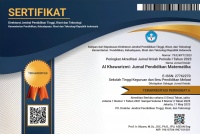ANALISIS MISKONSEPSI SISWA SMP PADA TEOREMA PYTHAGORAS MENGGUNAKAN FOUR TIER CERTAINTY OF RESPONSE INDEX (FTCRI)
DOI:
https://doi.org/10.46368/kjpm.v4i2.2330Abstract
Abstrak: Penelitan ini bertujuan untuk menganalisis miskonsepsi yang sering terjadi pada siswa SMP dalam memahami konsep teorema pythagoras menggunakan Four Tier Certainty of Response Index (FTCRI). Jenis penelitian pada penelitian ini adalah studi kasus dan bersifat deskriptif. subjek penelitian adalah siswa kelas VIII-I SMPN 7 Kota Serang dan dipilih sebanyak 6 siswa yang mengalami miskonsepsi berdasarkan hasil tes FTCRI. Instrumen penelitian berupa tes diagnostik four-tier dengan CRI yang disusun berdasarkan kurikulum merdeka. Data penelitian diolah berdasarkan kombinasi jawaban siswa pada tes diagnostik four-tier dan CRI. Hasil penelitian menunjukan terdapat 6% siswa mengalami miskonsepsi tingkat tinggi, 58% mengalami miskonsepsi tingkat sedang, dan 36% siswa yang mengalami miskonsepsi tingkat rendah. Hasil ini menunjukkan bahwa mayoritas siswa mengalami miskonsepsi tingkat sedang dalam pemahaman konsep teorema Pythagoras. Temuan miskonsepsi siswa dalam memahami konsep teorema Pythagoras tersebar dalam beberapa jenis diantaranya, kesalahpahaman siswa dalam menentukan sisi-sisi sebuah segitiga siku-siku, pemahaman yang salah tentang kebalikan teorema Pythagoras, kesalahpahaman konsep bilangan berpangkat dan bentuk akar, kesalahan dalam konsep perbandingan dan kesalahan dalam memodelkan permasalahan matematika. Penyebab dari miskonsepsi yang terjadi bersumber dari siswa, gura dan konteks pembelajaran. Karena itu, langkah efektif diperlukan guna meminimalisir miskonsepsi yang terjadi.
Â
Kata Kunci: Miskonsepsi, Tes Diagnostik Four-tier, Certainty of Response Index, Pythagoras
Â
Â
Abstract : This study aims to analyze misconceptions that often occur in junior high school students in understanding the concept of the Pythagorean theorem using the Four Tier Certainty of Response Index (FTCRI). The type of research in this research is a case study and is descriptive. The subjects of the study were students of grade VIII-I SMPN 7 Serang City and 6 students were selected who experienced misconceptions based on the results of the FTCRI test. The research instrument is a four-tier diagnostic test with CRI prepared based on an independent curriculum. The research data was processed based on a combination of students' answers on four-tier diagnostic tests and CRI. The results showed that 6% of students experienced high-level misconceptions, 58% experienced moderate-level misconceptions, and 36% of students experienced low-level misconceptions. These results show that the majority of students experience a moderate level of misconception in the understanding of the concept of the Pythagorean theorem. The findings of student misconceptions in understanding the concept of the Pythagorean theorem are scattered in several types, including, students' misunderstanding in determining the sides asked in a right triangle, wrong understanding of the reverse of the Pythagorean theorem, misunderstanding of the concept of rank numbers and root shapes, errors in the concept of comparison and errors in modeling mathematical problems. The cause of misconceptions that occur comes from students, gura and learning context. Therefore, effective steps are needed to minimize misconceptions that occur.
Â
Keywords: Misconceptions, Four-tier Diagnostic Test, Certainty of Response Index, PythagorasReferences
Aini, Imamah, Ningtyas, & Kusuma. (2020). Kemampuan Generalisasi Matematis Siswa SMP Kelas VIII Pada Materi Pola Bilangan. Universitas Muhammadiyah Jember, 5(1), 1–7.
Al-qonuni, S., & Afriansyah, E. A. (2023). Miskonsepsi siswa smp pada materi perbandingan dengan menggunakan four tier diagnostic test Pendahuluan. Jurnal Inovasi Pembelajaran Matematika:, 02(02), 205–214.
Astuti, I. A. D. et al. (2021). Four Tier-Magnetic Diagnostic Test (4T-MDT): Instrumen Evaluasi Medan Magnet Untuk Mengidentifikasi Miskonsepsi Siswa. JIPFRI (Jurnal Inovasi Pendidikan Fisika Dan Riset Ilmiah). Retrieved from https://journal.unuha.ac.id/index.php/JIPFRI/article/view/1205
Djadir, D., Arsyad, N., & Kalu, M. D. (2021). Penyebab Miskonsepsi Siswa Kelas 9 pada Materi Pecahan Bentuk Aljabar Berdasarkan Teori Konstruktivisme. Issues in Mathematics Education (IMED), 5(2), 143. https://doi.org/10.35580/imed23847
Fauziyah, S., Amalia, N., & Amelia, P. (2023). Analisis Faktor Penyebab Kecemasan Belajar Matematika Siswa Kelas X SMK Tunas Pembangunan. 1(4).
Ikbal et al. (2022). Design of Mathematics Learning Strategies Pythagorean Theorem Material with Scientific Approach to Reduce Students’ Misconceptions. EDUCTUM: Journal Research, 1(1), 75–79. https://doi.org/10.56495/ejr.v1i1.307
Kraeng, Y. F. (2021). Analisis Kesulitan Siswa Dalam Menyelesaikan Soal Cerita Pada Materi Statistika. Jurnal Ilmiah Pendidikan Matematika Al Qalasadi, 5(1), 72–80. https://doi.org/10.32505/qalasadi.v5i1.2366
Maison et al. (2020). Profil Miskonsepsi Materi Ekologi Menggunakan Four-Tier Test pada Peserta Didik Kelas X SMA. Jurnal Pene;Itian Pendidikan IPA (JPPIPA). Retrieved from http://jppipa.unram.ac.id/index.php/jppipa/article/view/314
Nur, A. Z. et al. (2023). Kajian Literatur: Penggunaan Asesmen Diagnostik Berformat Four-Tier untuk Mengidentifikasi Pemahaman Konsep dan Miskonsepsi. JIIP-Jurnal Ilmiah Ilmu …. Retrieved from http://www.jiip.stkipyapisdompu.ac.id/jiip/index.php/JIIP/article/view/2072
Nur Azizah, F., & Haerudin. (2021). Analisis Kesulitan Belajar Dalam Masalah Kecemasan Pada Pembelajaran Matematika. Jurnal Ilmu Pendidikan Matematika, 8(2), 624–635.
Patil, S. J. at al. (2019). Identification of Misconceptions in Science: Tools , Techniques & Skills for Teachers. Aarhat Multidisciplinary International Education Research Journal (AMIERJ), 8(2), 466–472. Retrieved from https://www.researchgate.net/profile/Rajendra-Chavan/publication/331249277_Identification_of_Misconceptions_in_Science_Tools_Techniques_Skills_for_Teachers/links/5c78eff8458515831f7835f0/Identification-of-Misconceptions-in-Science-Tools-Techniques-Skills-
Priyasmika, R., & Sholichah, N. (2022). Analisis Miskonsepsi Pada Materi Hidrolisis Garam Menggunakan Instrumen Tes Diagnostik Four Tier. Jurnal Riset Teknologi Dan Inovasi Pendidikan. Retrieved from http://journal.rekarta.co.id/index.php/jartika/article/view/397
Rahayu, N. S., & Afriansyah, E. A. (2021). Miskonsepsi Siswa SMP pada Materi Bangun Datar Segiempat. Plusminus: Jurnal Pendidikan Matematika, 1(1), 17–32. https://doi.org/10.31980/plusminus.v1i1.1023
Rahayu, R. D. (2021). Miskonsepsi Mahasiswa Menggunakan Four-Tier Diagnostic Test. SIMETRIS. Retrieved from https://www.sttrcepu.ac.id/jurnal/index.php/simetris/article/view/223
Rahmawaty, A., & Nurmeidina, R. (2023). Analisis Kesalahan Siswa Dalam Menyelesaikan Soal Ulangan Harian Matematika Pada Materi Teorema Phytagoras Di Masa New Normal. EMTEKA: Jurnal Pendidikan Matematika, 4(1), 126–140.
Tanujaya, B., & Mumu, J. (2020). Students’ misconception of HOTS problems in teaching and learning of mathematics. Journal of Physics: Conference Series. Retrieved from https://iopscience.iop.org/article/10.1088/1742-6596/1657/1/012081/meta
Wulandari, S., Gusmalini, A., & Zulfarina. (2021). Analisis Miskonsepsi Mahasiswa Pada Konsep Genetika Menggunakan Instrumen Four Tier Diagnostic Test. Jurnal Pendidikan Sains Indonesia. Retrieved from https://jurnal.usk.ac.id/JPSI/article/view/21153
Yohanes, R. S. (2022). Miskonsepsi dalam pembelajaran matematika dan cara mengatasinya. Prosiding Nasional Pendidikan : LPPM IKIP PGRI Bojonegoro, 41–52. Retrieved from https://prosiding.ikippgribojonegoro.ac.id/index.php/Prosiding/article/view/1595
Yufida Afkarina Nizar Isyam, Susanto, & Oktavianingtyas, E. (2016). Identifikasi Miskonsepsi Siswa Dalam Menyelesaikan Soal Timss Konten Aljabar Ditinjau Dari Tingkat Kecemasan Matematika. Tjyybjb.Ac.Cn, 18(2), 33–37. Retrieved from http://www.tjyybjb.ac.cn/CN/article/downloadArticleFile.do?attachType=PDF&id=9987
Yuliana, Y., Rahayu, R. R., & Firmansah, F. (2022). Kesalahan Siswa dalam Pemecahan Masalah Matematika pada Teorema Pythagoras. Edukatif : Jurnal Ilmu Pendidikan, 4(4), 5532–5543. https://doi.org/10.31004/edukatif.v4i4.3294
Downloads
Published
How to Cite
Issue
Section
Citation Check
License
Authors who publish with this journal agree to the following terms:
1. Authors retain copyright and grant the journal right of first publication with the work simultaneously licensed under a Creative Commons Attribution License that allows others to share the work with an acknowledgement of the work's authorship and initial publication in this journal.
2. Authors are able to enter into separate, additional contractual arrangements for the non-exclusive distribution of the journal's published version of the work (e.g., post it to an institutional repository or publish it in a book), with an acknowledgement of its initial publication in this journal.
3. Authors are permitted and encouraged to post their work online (e.g., in institutional repositories or on their website) prior to and during the submission process, as it can lead to productive exchanges, as well as earlier and greater citation of published work.






